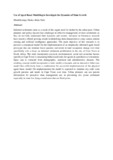Please use this identifier to cite or link to this item:
https://cris.library.msu.ac.zw//handle/11408/1650Full metadata record
| DC Field | Value | Language |
|---|---|---|
| dc.contributor.author | Shoko, Moreblessings | - |
| dc.contributor.author | Smit, Julian | - |
| dc.date.accessioned | 2016-06-28T11:19:30Z | - |
| dc.date.available | 2016-06-28T11:19:30Z | - |
| dc.date.issued | 2013-02 | - |
| dc.identifier.uri | http://www.ajol.info/index.php/sajg/article/viewFile/106995/96903 | - |
| dc.identifier.uri | http://hdl.handle.net/11408/1650 | - |
| dc.description.abstract | Informal settlements arise as a result of the urgent need for shelter by the urban poor. Urban planners and policy makers face challenges in effective management of slum settlements as they do not fully understand their dynamics and extents. Advances in Geomatics research have recently offered growing results in identifying slum characteristics using various remote sensing and artificial intelligence approaches. The main objective of this research is to propose a conceptual model for the implementation of an empirically informed agent based prototype that can simulate future patterns and trends in land occupation change over time specifically with a focus on informal settlement proliferation in the city of Cape Town in South Africa. The study incorporates physical, environmental, social and economic factors specific to Cape Town in structuring behavioural rules for agents in a predictive environment. Input data is extracted from demographic, statistical and administrative datasets. The resulting concept model incorporates a static model, a dynamic and an interactive behaviour model that collectively form a combination for successful implementation of the physical agent based model. On implementation the model is expected to simulate city wide slum growth patterns and trends in Cape Town over time. Urban planners can use pattern information for proactive slum management and in preventing risk prone settlement especially in some low lying coastal areas that are flood prone. | en_US |
| dc.language.iso | en | en_US |
| dc.relation.ispartofseries | South African Journal of Geomatics;Vol. 2, No. 1; p. 54-67 | - |
| dc.subject | Agent based modelling | en_US |
| dc.title | Use of agent based modelling to investigate the dynamics of slum growth | en_US |
| dc.type | Article | en_US |
| item.languageiso639-1 | en | - |
| item.fulltext | With Fulltext | - |
| item.grantfulltext | open | - |
| item.cerifentitytype | Publications | - |
| item.openairecristype | http://purl.org/coar/resource_type/c_18cf | - |
| item.openairetype | Article | - |
| Appears in Collections: | Research Papers | |
Files in This Item:
| File | Description | Size | Format | |
|---|---|---|---|---|
| Use of Agent Based Modelling to Investigate the Dynamics of Slum Growth.pdf | Abstract | 5.38 kB | Adobe PDF |  View/Open |
Page view(s)
116
checked on Apr 5, 2025
Download(s)
12
checked on Apr 5, 2025
Google ScholarTM
Check
Items in MSUIR are protected by copyright, with all rights reserved, unless otherwise indicated.



